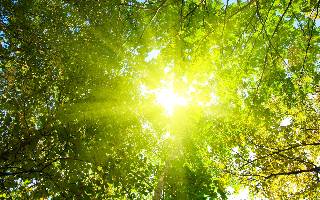Summary
This is a lesson that revolves around a modified version of The College Board's floating disks lab for AP biology. It can be used as an introduction or a wrap-up of a photosynthesis lesson.
Essential Question(s)
How does energy guide function?
Snapshot
Engage
Students will watch sun dancing toys and write down observations.
Explore
Students will conduct a lab with spinach and light.
Explain
Students will answer questions about the lab.
Extend
Students will read articles about photosynthesis and renewable energy.
Evaluate
Students will make a 2-minute documentary over their article.
Materials
Three solar dancing toys (Engage)
Light lamps (Engage & Explore)
Spinach (Explore)
Hole punch (Explore)
Clear cups (Explore)
Syringe without needle (Explore)
Baking soda (Explore)
Dish soap (Explore)
Water (Explore)
Copies of the articles (Extend)
Engage
Allow students the freedom to come in and watch them and giggle or whatever the students want to do. After a minute, post the question: "Why is this happening?" Have students use that question to write a speculation statement of what is happening with the toys. Then, have the students share their explanations with a partner.
They will revisit both the question and their original statement at the end, so have the students store it for later.
Explore
Distribute the lab handouts included. There are only three pre-lab questions; allow students to form lab groups and answer the pre-lab before starting the lab.
The procedures are on the handout, but what students will be doing is extracted the gases from leaves, then a carbonate solution and light will allow the leaves to go through photosynthesis, which produces oxygen gas that makes the leaves buoyant (thus float).
After the students are done collecting the data, have them answer the post lab questions.
Explain
Once the students are done with the lab, Show a diagram of photosynthesis within the chloroplast. Then, post the equation for photosynthesis on the board.
6CO2 + 6H2O ? C6H12O6 + 6O2
Then ask the students to write down the answers to the following questions in the first part of a Think, Pair, Share.
In the lab, where did the carbon dioxide come from?
In the lab, what role did the light play? What did the light do?
In the lab, what did you observe to let you know that photosynthesis was happening? How does that observation fit into the equation?
Do you think sugar was still being made in the leaves in the dark treatment?
After they've written an answer, have them share their answers with an elbow partner.
Once they have confidence in their answers, have various groups share their speculations to the whole class.
Extend
Group students so that there are five groups (or more if you need to, there are just five natural groups with the articles provided). Assign one of the included articles to each group.
Have the students read through their article, then CUS and Discuss. That means that the students will:
Circle words they don't know
Underline details that support the main idea
Star the most important parts/main idea
Discuss what they marked with their group
Evaluate
Once the students have discussed their article with their group, tell the students that they will be making a Two-Minute Documentary to present the information from their article to the entire class.
Resources
Solar toys (Engage): http://www.officeplayground.com/desk-toys-c13/solar-motion-toys-c77.html
Sunflower video (Alternate Engage): https://www.youtube.com/watch?v=lwI0tGzr4S8
Lab Version that inspired Explore Handout: http://www.biologyjunction.com/5b-photoinleafdiskslesson.pdf
Think, Pair, Share (Explain): https://learn.k20center.ou.edu/strategy/d9908066f654727934df7bf4f5064b49
https://www.sciencedaily.com/releases/2016/06/160624100258.htm
http://education.seattlepi.com/difference-between-photosynthesis-solar-cells-4700.html
CUS and Discuss: https://learn.k20center.ou.edu/strategy/d9908066f654727934df7bf4f5073969
Two-Minute Documentary (Evaluate): https://learn.k20center.ou.edu/strategy/d9908066f654727934df7bf4f507bb21


